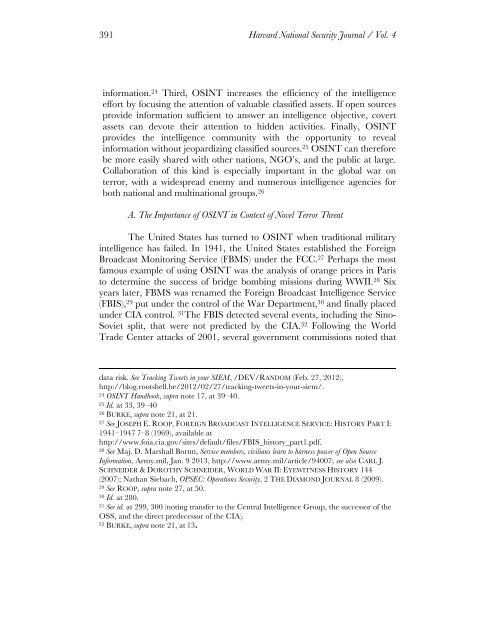Vo.4-Moshirnia-Final
Vo.4-Moshirnia-Final
Vo.4-Moshirnia-Final
You also want an ePaper? Increase the reach of your titles
YUMPU automatically turns print PDFs into web optimized ePapers that Google loves.
391 Harvard National Security Journal / Vol. 4<br />
information. 24 Third, OSINT increases the efficiency of the intelligence<br />
effort by focusing the attention of valuable classified assets. If open sources<br />
provide information sufficient to answer an intelligence objective, covert<br />
assets can devote their attention to hidden activities. <strong>Final</strong>ly, OSINT<br />
provides the intelligence community with the opportunity to reveal<br />
information without jeopardizing classified sources. 25 OSINT can therefore<br />
be more easily shared with other nations, NGO’s, and the public at large.<br />
Collaboration of this kind is especially important in the global war on<br />
terror, with a widespread enemy and numerous intelligence agencies for<br />
both national and multinational groups. 26<br />
A. The Importance of OSINT in Context of Novel Terror Threat<br />
The United States has turned to OSINT when traditional military<br />
intelligence has failed. In 1941, the United States established the Foreign<br />
Broadcast Monitoring Service (FBMS) under the FCC. 27 Perhaps the most<br />
famous example of using OSINT was the analysis of orange prices in Paris<br />
to determine the success of bridge bombing missions during WWII. 28 Six<br />
years later, FBMS was renamed the Foreign Broadcast Intelligence Service<br />
(FBIS), 29 put under the control of the War Department, 30 and finally placed<br />
under CIA control. 31 The FBIS detected several events, including the Sino-<br />
Soviet split, that were not predicted by the CIA. 32 Following the World<br />
Trade Center attacks of 2001, several government commissions noted that<br />
data risk. See Tracking Tweets in your SIEM, /DEV/RANDOM (Feb. 27, 2012),<br />
http://blog.rootshell.be/2012/02/27/tracking-tweets-in-your-siem/.<br />
24 OSINT Handbook, supra note 17, at 39–40.<br />
25 Id. at 33, 39–40<br />
26 BURKE, supra note 21, at 21.<br />
27 See JOSEPH E. ROOP, FOREIGN BROADCAST INTELLIGENCE SERVICE: HISTORY PART I:<br />
1941–1947 7–8 (1969), available at<br />
http://www.foia.cia.gov/sites/default/files/FBIS_history_part1.pdf.<br />
28 See Maj. D. Marshall Bornn, Service members, civilians learn to harness power of Open Source<br />
Information, Army.mil, Jan. 9 2013, http://www.army.mil/article/94007; see also CARL J.<br />
SCHNEIDER & DOROTHY SCHNEIDER, WORLD WAR II: EYEWITNESS HISTORY 144<br />
(2007); Nathan Siebach, OPSEC: Operations Security, 2 THE DIAMOND JOURNAL 8 (2009).<br />
29 See ROOP, supra note 27, at 50.<br />
30 Id. at 280.<br />
31 See id. at 299, 300 (noting transfer to the Central Intelligence Group, the successor of the<br />
OSS, and the direct predecessor of the CIA).<br />
32 BURKE, supra note 21, at 13.
















